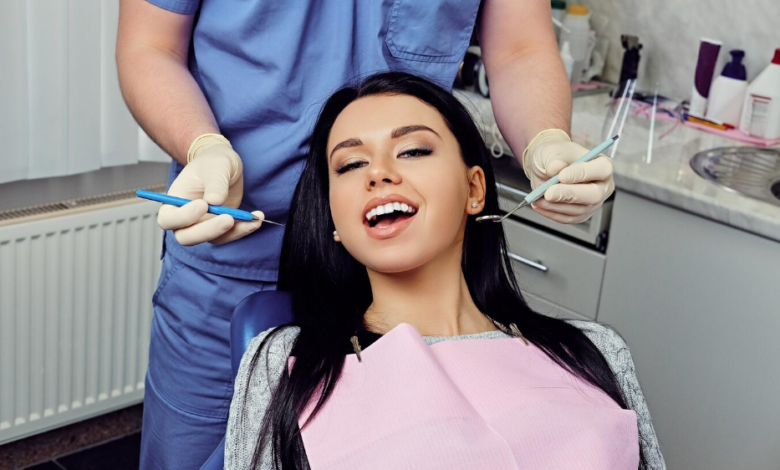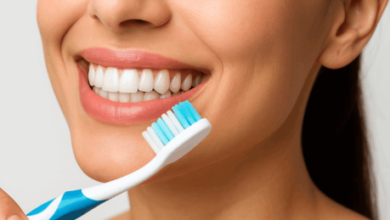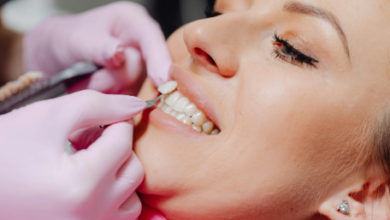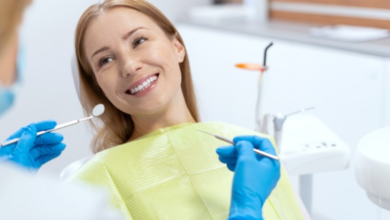Finding an Emergency Dentist in San Francisco: Your Guide to Urgent Care

Nobody likes a dental emergency. They pop up out of nowhere, usually when you least expect them, and can really mess up your day. When you’re suddenly dealing with a bad toothache or a chipped tooth, knowing where to go for quick help can make a huge difference. If you’re in San Francisco, especially if you need an emergency dentist in San Francisco, this guide is here to help you figure out what to do and where to find good care fast.
Key Takeaways
- Dental emergencies are sudden and can be scary, but knowing the signs helps you act fast.
- Finding an emergency dentist in San Francisco means looking for places that can see you quickly, especially in areas like 94111.
- When you get to the dentist, they’ll check things out, tell you what’s wrong, and then fix it up.
- You can do some things at home to feel better until you get to the dentist, like using pain relievers or cold packs.
- Regular dental visits and good brushing habits can help you avoid most dental emergencies in the first place.
Understanding Dental Emergencies
Identifying Urgent Dental Conditions
Okay, so what actually counts as a dental emergency? It’s more than just a little toothache. A true dental emergency is any situation that poses an immediate threat to your oral health or causes severe pain. Think about it this way: if you ignore it, could it get way worse, fast? If the answer is yes, it’s probably an emergency.
- Uncontrolled bleeding in the mouth
- Severe pain that doesn’t go away with over-the-counter meds
- A knocked-out tooth
- A painful infection or abscess
- Trauma to the face or jaw
Ignoring a dental emergency can lead to serious complications, like infections spreading to other parts of your body. Don’t wait it out. Get it checked out.
Common Causes of Dental Pain
Dental pain can come from all sorts of things. Sometimes it’s obvious, like after you bite down on something way too hard and crack a tooth. Other times, it’s more sneaky. Cavities are a big one – they slowly eat away at your teeth, and eventually, that hits a nerve. Gum disease can also cause a lot of pain and sensitivity. And then there are things like impacted teeth (wisdom teeth, anyone?) or even just grinding your teeth at night. Here’s a quick rundown:
- Tooth decay (cavities)
- Gum disease (gingivitis, periodontitis)
- Tooth fractures or cracks
- Abscesses or infections
- Impacted teeth
When to Seek Immediate Care
Knowing when to head to an emergency dentist in San Francisco is key. Don’t just tough it out if you don’t have to. If you’re dealing with any of the following, it’s time to call for help:
- Knocked-Out Tooth: Time is of the essence. The sooner you get to a dentist, the better the chance of saving the tooth.
- Severe Toothache: If the pain is unbearable and not responding to pain relievers, it’s an emergency.
- Infection/Abscess: Look for swelling, redness, and pus. These can spread quickly and become dangerous.
- Broken or Fractured Tooth: Especially if it’s causing pain or has sharp edges that are cutting your mouth.
- Lost Filling or Crown: While not always an emergency, it can be if the exposed tooth is sensitive or painful.
Finding an Emergency Dentist in San Francisco
Dental emergencies never happen when it’s convenient, do they? If you’re in San Francisco and suddenly find yourself with a throbbing toothache or a chipped tooth after biting into something questionable, knowing where to turn is super important. Let’s break down how to find an emergency dentist in the city.
Locating a Nearby Emergency Dentist
Okay, so you need a dentist, and you need one now. Where do you even start? Well, the internet is your friend. A quick search for “emergency dentist San Francisco” or “urgent dental care near me” will give you a bunch of options. Don’t just click the first thing you see, though. Take a minute to check out a few different places. Look at their websites, see if they have good reviews, and make sure they actually offer emergency services. Some dentists only do regular appointments, so you want to be sure they can handle your urgent situation. Also, consider the location. Is it easy to get to from where you are? Especially if you’re in pain, you don’t want to be driving all over the city.
Key Factors in Choosing a Provider
So, you’ve got a list of potential dentists. Now what? Here’s what I’d be looking for:
- Availability: Can they see you ASAP? This is the whole point of emergency care.
- Experience: Do they have experience with the type of problem you’re having? A general dentist might be fine for a simple toothache, but if you’ve got a more complex issue, you might want someone who specializes in emergency dental work.
- Reviews: What are other people saying about them? A few bad reviews aren’t necessarily a deal-breaker, but if you see a pattern of complaints, that’s a red flag.
- Payment Options: How do they handle payment? Do they take your insurance? Do they offer payment plans? You don’t want to get stuck with a huge bill you can’t afford.
Finding the right emergency dentist can feel overwhelming when you’re already stressed and in pain. Take a deep breath, do a little research, and trust your gut. You’ll find someone who can help.
Emergency Dental Services in 94111
If you happen to be in the 94111 zip code (that’s around the Financial District and parts of SoMa), you’re in luck. There are several dental practices in that area that offer emergency services. Yerba Buena Dentistry is one example. These clinics often provide a range of urgent treatments, from dealing with infections to fixing broken teeth. It’s always a good idea to call ahead to confirm they can see you and to describe your situation. This helps them prepare for your visit and ensure they have the right equipment and staff available. Plus, they can give you some initial advice on how to manage your pain or injury while you’re on your way.
What to Expect During an Emergency Visit
So, you’ve got a dental emergency in San Francisco and you’re heading to an emergency dentist. What’s it actually going to be like? Let’s break it down.
Initial Assessment and Diagnosis
First things first, the dentist will need to figure out what’s going on. Expect a quick but thorough examination. They’ll ask you about your pain, how it started, and any relevant medical history. X-rays are pretty common to get a better look at what’s happening beneath the surface – things like infections or hidden damage. They might poke around a bit, gently, to see where it hurts the most. It’s all about getting to the root (pun intended!) of the problem.
Treatment Options for Urgent Cases
Okay, diagnosis done. Now what? The dentist will explain your options. This could be anything from a filling for a cavity to a root canal for a deeper infection, or even an extraction if the tooth is beyond saving. They’ll walk you through the pros and cons of each choice, and what to expect during the procedure. Don’t be afraid to ask questions! It’s your mouth, and you deserve to understand what’s happening. Here’s a quick rundown of possible treatments:
- Pain Relief: Local anesthetics to numb the area.
- Infection Control: Antibiotics if there’s an infection.
- Repair Work: Fillings, crowns, or bonding for damaged teeth.
It’s important to remember that emergency dental care focuses on addressing the immediate problem. You might need follow-up appointments for more extensive work later on.
Post-Treatment Care and Follow-Up
So, you’ve had your emergency treatment. Now comes the aftercare. The dentist will give you specific instructions on how to take care of your mouth. This might include things like:
- Taking pain medication as prescribed.
- Using a special mouthwash.
- Avoiding certain foods.
- Scheduling a follow-up appointment.
They’ll also let you know what to watch out for – signs of infection, increased pain, or anything else that seems off. Make sure you follow their instructions carefully to ensure a smooth recovery. And don’t hesitate to call if you have any concerns!
Managing Dental Pain Before Your Appointment
Alright, so you’ve got a dental emergency in San Francisco and you’re waiting to see an emergency dentist. What can you do in the meantime? It’s all about managing that pain and preventing things from getting worse. Here’s the lowdown:
Effective Home Remedies for Temporary Relief
Okay, first things first, let’s talk about what you can do at home to ease the pain. These aren’t miracle cures, but they can definitely help you get through until you can get to an emergency dentist near you.
- Saltwater Rinse: This is like the golden rule of dental discomfort. Mix a teaspoon of salt in a cup of warm water and swish it around your mouth for about 30 seconds. It helps clean the area and can reduce inflammation. Do this a few times a day.
- Cold Compress: If you’ve got swelling, a cold compress is your best friend. Wrap an ice pack (or even a bag of frozen peas) in a towel and apply it to the outside of your cheek for 15-20 minutes at a time. Repeat every few hours.
- Clove Oil: This stuff is pretty potent. Dab a tiny bit of clove oil onto a cotton swab and gently apply it to the affected tooth. Clove oil has eugenol, which is a natural anesthetic. Be careful not to swallow it, and don’t use too much!
Over-the-Counter Pain Management
Sometimes, home remedies just aren’t enough, and that’s okay. Over-the-counter pain relievers can be a lifesaver.
- Ibuprofen (Advil, Motrin): This is usually the go-to for dental pain because it helps with both pain and inflammation. Follow the dosage instructions on the bottle.
- Acetaminophen (Tylenol): If you can’t take ibuprofen (maybe you have stomach issues or allergies), acetaminophen is another option. Again, stick to the recommended dosage.
- Topical Anesthetics: You can find gels and creams at the drugstore that contain benzocaine. These can numb the area temporarily. Just be aware that some people can have allergic reactions, so test a small amount first.
First Aid for Dental Injuries
If you’ve had an actual injury, like a knocked-out tooth or a broken filling, here’s what you need to do:
- Knocked-Out Tooth: Time is of the essence here. Gently rinse the tooth (don’t scrub it!) and try to put it back in the socket. If that’s not possible, keep it in milk or a saline solution and get to an emergency dentist in San Francisco ASAP.
- Broken Tooth or Filling: Rinse your mouth with warm water to clean the area. If there are any sharp edges, cover them with dental wax (you can find this at most drugstores) to protect your tongue and cheeks.
- Lost Crown: If your crown falls off, try to clean it and put it back on with some dental adhesive (also available at drugstores). If you can’t get it to stay, keep the crown safe and bring it with you to the dentist.
Remember, these are just temporary fixes. You still need to see a dentist as soon as possible. Think of these tips as a way to make the wait a little more bearable. Don’t delay seeking professional help, especially if you’re in severe pain or have signs of infection (like fever or swelling). Your oral health is important, and getting prompt care can prevent bigger problems down the road.
Preventing Future Dental Emergencies
It’s always better to avoid a dental emergency in the first place, right? While you can’t predict everything, there are definitely steps you can take to lower your risk. Think of it like preventative maintenance for your mouth. A little effort now can save you a lot of pain (and money) later.
Importance of Regular Dental Check-Ups
Regular check-ups are super important because your dentist can spot problems early. I mean, really early, before they even start hurting. They can see things you can’t, like tiny cavities or gum issues. Plus, they clean your teeth really well, getting rid of plaque and tartar that you might miss at home. It’s like taking your car in for an oil change – keeps everything running smoothly.
Maintaining Good Oral Hygiene Practices
Okay, this one’s a no-brainer, but it’s worth repeating: brush and floss! Seriously, do it. Brush at least twice a day, and floss every day. It’s not just about having fresh breath; it’s about getting rid of the bacteria that cause cavities and gum disease. And don’t forget to brush your tongue! That’s where a lot of bacteria hang out. I like to use an electric toothbrush, but whatever works for you is fine. Just be consistent.
Protective Measures for Your Teeth
Think about how you use your teeth. Are you a nail-biter? Do you chew on ice? Those habits can really damage your teeth over time. And if you play sports, wear a mouthguard! It’s a simple way to protect your teeth from getting knocked out. Also, be careful with hard foods. I know, biting into a crisp apple is great, but sometimes it’s not worth the risk.
Taking care of your teeth isn’t just about avoiding pain; it’s about your overall health. Your mouth is connected to the rest of your body, and problems in your mouth can affect other parts of your health. So, treat your teeth well, and they’ll treat you well in return.
Cost and Insurance for Emergency Dental Care
Understanding Emergency Dental Costs
Okay, so you’ve got a dental emergency in San Francisco. First thought: “Ouch!” Second thought: “How much is this gonna cost me?” Emergency dental work, like anywhere, can be a bit pricey. It’s not just a regular check-up; you’re paying for immediate attention, specialized care, and often after-hours service. The exact cost depends on what’s wrong. A simple fix, like a filling that popped out, will be less than a root canal or fixing a broken tooth after a fall. Generally, you can expect to pay more than a standard dental visit.
Here’s a rough idea of what some common emergency procedures might run you (these are just estimates, so call around!):
| Procedure | Estimated Cost | Notes |
| Emergency Exam | $75 – $150 | Just to get you in the door and see what’s up. |
| Simple Extraction | $150 – $300 | If a tooth is too far gone. |
| Filling | $100 – $400 | Depends on the material (composite, amalgam, etc.) and the size. |
| Root Canal (front tooth) | $700 – $1200 | Ouch, both literally and figuratively. |
| Root Canal (molar) | $1000 – $2000 | Even more ouch. |
Don’t freak out too much about these numbers. The best thing to do is get a proper diagnosis and a clear estimate from the dentist before they start working. Ask questions! Understand what they’re doing and why.
Navigating Dental Insurance Coverage
Alright, let’s talk insurance. Dental insurance can be a lifesaver, but it can also be confusing. Most plans do cover emergency dental care, but the extent of the coverage varies a lot. Some plans might cover 80% of the cost after your deductible, while others might only cover 50%, or have annual limits that you might hit quickly with a big emergency.
Here’s the deal:
- Know your plan: Before you even think about needing emergency dental work, read your policy. Understand your deductible (how much you pay before insurance kicks in), your co-insurance (the percentage you pay after the deductible), and your annual maximum (the most the insurance will pay in a year).
- In-network vs. out-of-network: Going to a dentist who’s in your insurance network usually means lower out-of-pocket costs. But in an emergency, you might not have a choice. Find out how your plan handles out-of-network care.
- Pre-authorization: Some procedures might require pre-authorization from your insurance company. This basically means the dentist has to get approval from the insurance company before doing the work. In an emergency, this might not be possible, but it’s worth asking about.
- Don’t be afraid to call: Call your insurance company before you go to the dentist (if possible) or right after. Explain the situation and ask about your coverage. Get everything in writing if you can.
It’s always a good idea to keep your insurance card handy (or a picture of it on your phone). That way, you can quickly provide the information to the dental office. Also, remember that even with insurance, you’ll likely have some out-of-pocket costs. Be prepared for that.
Payment Options for Urgent Treatments
Okay, so what if you don’t have insurance, or your insurance doesn’t cover enough? Don’t panic! There are still options. Many dental offices in San Francisco understand that emergency dental care can be a financial burden, and they offer different payment plans to help you manage the cost.
Here are some common payment options:
- Payment Plans: Many dentists offer in-house payment plans, where you pay off the cost of the treatment in installments over a few months. Ask about interest rates and fees.
- CareCredit: This is a credit card specifically for healthcare expenses, including dental work. It often offers low- or no-interest financing for a certain period. Just make sure you can pay it off before the promotional period ends, or you’ll get hit with high interest charges.
- Dental Savings Plans: These aren’t insurance, but they offer discounts on dental services at participating dentists. You pay an annual fee to join the plan, and then you get a percentage off the cost of treatment.
- Loans: Personal loans from banks or credit unions can be used to pay for dental work. Compare interest rates and terms before you borrow.
- Charitable Organizations: Some organizations offer financial assistance for dental care to low-income individuals and families. Do some research to see if there are any programs in your area.
Don’t be shy about discussing payment options with the dental office. They’re used to dealing with these situations, and they want to help you get the care you need without breaking the bank. The important thing is to address the emergency and then figure out the financial stuff. Your oral health is worth it!
Wrapping Things Up
So, there you have it. Dealing with a dental emergency can feel pretty scary, especially when you’re in pain and not sure where to go. But knowing there are places like Yerba Buena Dentistry in San Francisco, ready to help quickly, can make a big difference. They’re all about getting you out of pain and back to feeling good. Remember, taking care of your teeth regularly can help you avoid these kinds of surprises, but if something does happen, it’s good to know you’ve got options. Don’t wait if you’re hurting; getting help fast is always the best plan.
Frequently Asked Questions
What counts as a dental emergency?
A dental emergency is a problem that needs quick attention to save a tooth, stop pain, or prevent bigger health issues. This could be a bad toothache, a broken tooth, or losing a filling.
How do I find an emergency dentist in San Francisco?
You should look for a dentist who handles emergencies. Many dental offices have special hours for urgent cases, or they might have an emergency number you can call. Websites and online maps can also help you find one nearby.
What happens when I go to an emergency dentist?
When you arrive, the dental team will first check what’s wrong. They’ll ask about your pain and might take X-rays. Then, they’ll explain what treatment you need and start fixing the problem to make you feel better.
What can I do for dental pain before seeing a dentist?
To ease pain before your appointment, you can rinse your mouth with warm salt water, use a cold pack on your face, or take over-the-counter pain medicine like ibuprofen. Don’t put aspirin directly on your tooth or gums.
How can I avoid dental emergencies in the future?
Regular dental check-ups are super important because dentists can spot small problems before they become big emergencies. Brushing and flossing daily also keeps your teeth and gums healthy.
Will my insurance cover emergency dental care?
The cost of emergency dental care can change depending on what treatment you need. It’s a good idea to ask the dental office about payment options and if they work with your dental insurance plan.




